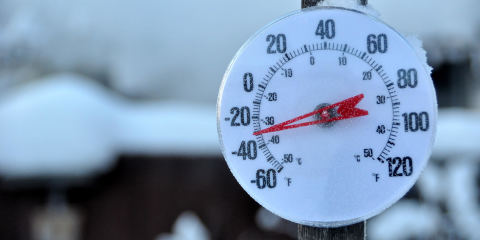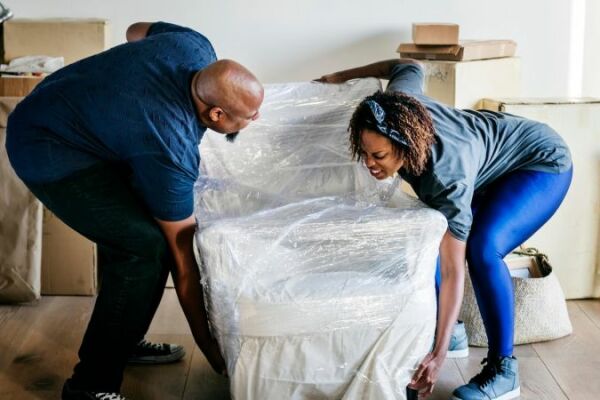A winter move may conjure the unpleasant image or memory of heading out into a polar vortex to dig yourself out after the latest blizzard, but despite the inconveniences of the season, winter moves also offer some compelling advantages: they can be cheaper than relocating during the peak summer months, and there will be less competition for moving companies and truck rentals.
Sometimes, moving is a choice and you can postpone your relocation till the summer; other times, you have no other option but to pack up and move during the winter. If you’re planning a winter relocation, follow these rules to make sure your move goes as smoothly as possible.
1. Some items need special care.
Thanks to the frigid temperatures and dry air, some of your household goods will require extra attention if you are planning to move or ship them in the winter, including:
- Appliances
- Electronics
- Wooden furniture
- Glass, dishware, and mirrors
- Boxes
- Musical instruments
- Plants
- Grandfather clocks
Try to pack or make arrangements for these vulnerable items as far in advance as possible to make sure there is enough time to take any required precautions. Here’s how to handle each of these special items:
Appliances
Appliances, especially ones that use water, can be particularly tricky to move or ship during the winter. This includes:
- Washers and dryers
- Refrigerators
- Ice makers
- Space heaters
- Dishwashers
- Water softeners
| PROBLEM | SOLUTION |
|---|---|
| If appliances are exposed to low temperatures for too long, any water that remains inside the internal components may freeze and expand, which can lead to cracked pipes and damage to water pumps, valves, and drain lines. | When you’re packing appliances to move or ship, drain out and dry up as much water as possible. Then, wrap the appliance in an extra layer of moving blankets to insulate it against the cold. You can also request a temperature controlled truck. |
Electronics
You should always take extra care when packing up electronics, regardless of the season. This includes:
- Televisions
- Stereo equipment and speakers
- Desktop computers
- Monitors
- Printers, scanners, and copiers
- Video game equipment
- DVD and Blu-ray players
| PROBLEM | SOLUTION |
|---|---|
| As the ambient temperature decreases, electronics can develop condensation inside their internal components, which can lead to water damage. | Wrap electronics in an extra layer of moving blankets for added insulation, and pack small components like cords into sealed plastic bags. If you can, move these items in your personal vehicle, where you’ll have more control over the temperature. You should also give any electronics a full 24 hours to return to room temperature after you move in before plugging them in. |
| TV TIP: Full-service moving companies are often equipped to move televisions, but most consolidated freight or LTL shipping services will not ship televisions because of the high risk of damage. If you’re moving most of your stuff yourself and are shipping a few items separately, plan to transport your TV in your personal vehicle. |
Wooden furniture
| PROBLEM | SOLUTION |
|---|---|
| Cool temperatures and low humidity can lead to cracks and warping, as well as the deterioration of any screws, glue, bolts, and fabric upholstery. | Apply a layer of wax to wood furniture before you pack it, ideally 1-2 weeks ahead of time. This will help seal in moisture, as well as prevent scratches, dust, and dirt. You should also disassemble any wood furniture as much as possible, and wrap each component individually in moving blankets and shrink wrap—moving blankets will keep it warmer longer, and shrink wrap will seal out any moisture. |
Glass, dishware, and mirrors
| PROBLEM | SOLUTION |
|---|---|
| When exposed to cold temperatures, glass items like frames, dishware, glassware, and mirrors, become more brittle and are particularly at risk for breakage, cracking, or chipping. | Wrap each plate, cup, frame, and glass item individually in clean rags or lots of wrapping paper and bubble wrap to insulate it against the cold. If possible, double-wrap everything in thick blankets to ease the transition between the warm indoors and cold truck. You may also wish to consider loading these items onto the truck last to reduce their exposure to the cold. |
Boxes
| PROBLEM | SOLUTION |
|---|---|
| With cold often comes snow, so if you’re moving boxes in the cold, your main concern will be moisture rather than temperature. When boxes get wet, they weaken and are more susceptible to tearing. | Make sure your moving boxes are securely taped, and cover them with plastic or towels while they are being loaded or unloaded so they don’t get wet. Don’t place them directly on the truck bed; instead, lay down a tarp, or use plastic boxes. |
| PACKING TIP: Always use plastic containers for moving paper items like photographs, artwork, or other paperwork, as well as soft items like pillows and bedding. |
Musical instruments
Woodwind and string instruments are the most vulnerable to the cold.
| PROBLEM | SOLUTION |
|---|---|
| Like wooden furniture, exposure to cold temperatures and low humidity can dry out the wood, leading to cracks or warping. | Take extra care when wrapping musical instruments. Place them in a special case if you have one, and wrap the case in extra moving blankets for further insulation. If you can, transport them in your personal vehicle. |
Plants
| PROBLEM | SOLUTION |
|---|---|
| Most houseplants won’t tolerate extreme cold for extended periods, and many movers won’t transport them in the back of a moving truck. | Wrap planters and pots in extra layers of packing paper and bubble wrap to insulate their roots. Move plants in your personal vehicle, if possible. If you don’t have space, plants make great going away gifts for your loved ones. |
| GREEN THUMB TIP: Water your plants a few days before you move, and if you have a long ride, pack a spray bottle filled with water to mist them occasionally. If you’re planning to stay anywhere overnight en route, move your plants indoors and unwrap the roots to allow them to breathe. |
Grandfather clocks
| PROBLEM | SOLUTION |
|---|---|
| Cold weather can cause oil left in any pivot points to gum up. Small components can also contract and restrict the operation of any moving parts. | Disassemble your clock as much as possible, remove the weights and pendulum, and wrap each component in towels or blankets and shrink wrap to seal out water. When you arrive, give your clock at least 24 hours to reach room temperature before starting it back up again. |
| PACKING TIP: If you’re moving from a warm climate to a cold one, pack any of the above items for the cold, and keep cold weather gear handy in your personal vehicle. |
2. Limit loading and unloading time
To the best of your ability, try to minimize the amount of time your vulnerable belongings are exposed to the cold. Load the least vulnerable items first, and save appliances, electronics, and other belongings till the end. When you arrive, unload the most vulnerable items first, and give them enough time to return to room temperature before you use them again.
| SAFETY TIP: Whatever you do, don’t rush loading and unloading—your delicate belongings are much more likely to sustain damage if you slip on a patch of ice and drop them than if they are just exposed to the cold. |
3. Use the right packing materials
Insulated packing materials, such as blankets, will protect your belongings from the cold, as well as provide a layer of padding that will help keep your fragile items safer in transit.
4. Create a safe working environment
Whether you’re moving yourself or have hired professional movers or a shipping company to transport your belongings, one of the most important things you can do to prevent injury and damage to your belongings is to clear a path in and out of your house:
- Shovel snow and sprinkle ice melt or salt to remove any ice.
- Check the snowplow schedule so you can take care of that mountain of snow the plow left at the foot of your driveway before you move or before any belongings you shipped separately are due to arrive.
- Lay down plastic or cardboard sheets throughout the house so you and your moving team don’t make a mess of the floor by tracking in slippery snow or dirt while you’re loading and unloading.
| MOVING TIP: Keep a shovel, as well as salt, sand, or kitty litter in your personal vehicle, or in the back of your moving truck if you rented one, in case you get stuck en route. You should also keep a stash of other winter safety items, such as candles, thermal blankets, and warm, weather-appropriate gear in your moving vehicle, if possible. |
If you can, you should also try to time your move with safety in mind. It gets dark earlier in the winter, so timing your loading and unloading during daylight hours is ideal. If you find yourself working in the dark, make sure you have bright outdoor lighting in place.
Before you move, call your new utility providers and set up your services so they are activated a few days before you are due to arrive. No matter how many other safety precautions you take, it’s tough to stay safe and warm when you don’t have heat or electricity.
5. Hire movers and shippers
Professional movers and shipping companies have the benefit of experience when it comes to packing, loading, and driving in winter conditions. Their expertise can save you a lot of stress and heartbreak during the moving process.
If you only have a few vulnerable items to move, such as a grandfather clock or a few pieces of wooden furniture, and are comfortable handling the rest of your stuff on your own, commercial freight services can be an economical alternative to hiring professional movers to handle your whole move.
6. Make a Plan B
Keep an eye on the weather forecast in the days and weeks leading up to your move, and have a backup plan in place in the event that you need to delay your move.
If you can’t move into your new house right away for any reason, look for climate-controlled storage in the meanwhile.
7. Be prepared for delays
Unsurprisingly, you are more likely to experience weather-related delays in the winter. While inconvenient, a late arrival is preferable to having your belongings arrive on time but damaged. Add a few days of buffer to your moving schedule to allow for any unexpected weather delays.
Conclusion
Moving in the winter can be tough. Follow these 7 rules to make sure your move goes smoothly:
- Protect vulnerable belongings
- Limit loading and unloading time
- Use the right packing materials
- Create a safe working environment
- Hire movers or shippers
- Have a Plan B, just in case
- Be prepared for delays
If you’re moving in the winter or have items to ship long distance, we can help.




